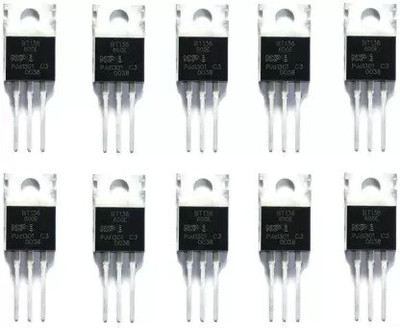
Get notified when this item comes back in stock.
ELPH Zener Diode 4.7 Volts 1/4 Watt pieces 20 Electronic Components Electronic Hobby Kit
Share
ELPH Zener Diode 4.7 Volts 1/4 Watt pieces 20 Electronic Components Electronic Hobby Kit
4.6
10 Ratings & 0 ReviewsSpecial price
₹179
₹299
40% off
Sold Out
This item is currently out of stock
Highlights
- Power Source: DC
- Material: Copper
- Weight: 25
Seller
Description
The zener diode is high-speed switching diode fabricated in planar technology, and encapsulated in hermetically sealed leaded glass. A Zener diode is a type of diode that permits current to flow in the forward direction like a normal diode, but also in the reverse direction if the voltage is larger than the breakdown voltage known as "Zener knee voltage" or "Zener voltage". Named for Clarence Zener, discoverer of this electrical property. A conventional solid-state diode will not let significant current flow if it is reverse-biased below its reverse breakdown voltage. By exceeding the reverse bias breakdown voltage, a conventional diode is subject to high current flow due to avalanche breakdown. Unless this current is limited by external circuitry, the diode will be permanently damaged. In case of large forward bias (current flow in the direction of the arrow), the diode exhibits a voltage drop due to its junction built-in voltage and internal resistance. The amount of the voltage drop depends on the semiconductor material and the doping concentrations. A Zener diode exhibits almost the same properties, except the device is specially designed so as to have a greatly reduced breakdown voltage, the so-called Zener voltage. A Zener diode contains a heavily doped p-n junction allowing electrons to tunnel from the valence band of the p-type material to the conduction band of the n-type material. In the atomic model, this tunneling corresponds to the ionization of covalent bonds. The Zener effect was discovered by physicist Clarence Melvin Zener. A reverse-biased Zener diode will exhibit a controlled breakdown and let the current flow to keep the voltage across the Zener diode at the Zener voltage. For example, a diode with a Zener breakdown voltage of 4.7 V will exhibit a voltage drop of 4.7 V if reverse bias voltage applied across it is more than its Zener voltage. However, the current is not unlimited, so the Zener diode is typically used to generate a reference voltage for an amplifier stage.
Read More
Specifications
In The Box
|
General
| Brand |
|
| Model Number |
|
| Skillset |
|
| Type |
|
| Minimum Age |
|
| ROHS Complaint |
|
| Material |
|
| Age Group |
|
| Suitable For Gifting |
|
Dimensions
| Width |
|
| Height |
|
| Weight |
|
Power Features
| Battery Type |
|
| No Of Batteries |
|
| Battery Size |
|
| Power Source |
|
| Other Power Features |
|
Ratings & Reviews
4.6
★
10 Ratings &
0 Reviews
- 5★
- 4★
- 3★
- 2★
- 1★
- 6
- 4
- 0
- 0
- 0
Have you used this product? Be the first to review!
Be the first to ask about this product
Safe and Secure Payments.Easy returns.100% Authentic products.
Back to top




